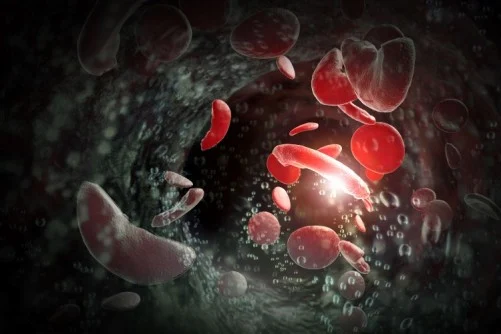A bone marrow transplant technique refined by researchers at Johns Hopkins Medicine is proving to be a viable and more affordable alternative to recently approved gene therapies for sickle cell disease, according to a nationwide clinical trial.
The treatment, known as reduced-intensity haploidentical bone marrow transplantation, showed a 95% survival rate two years after transplant among trial participants. Even more significant, 88% of patients were considered cured and experiencing no disease-related events after the procedure.
These findings, published February 25 in The New England Journal of Medicine Evidence, come at a pivotal moment when newer gene therapy treatments for sickle cell disease have captured headlines but remain prohibitively expensive for many patients.
“Our results with allogeneic transplant are every bit as good as or better than what you see with gene therapy,” said Richard Jones, M.D., professor of oncology and director of the bone marrow transplantation program at the Johns Hopkins Kimmel Cancer Center.
Unlike traditional transplants that required perfectly matched donors, this approach uses “half-matched” donors such as parents, siblings, or even cousins. This broadens the pool of potential donors significantly—a crucial advancement for a disease that predominantly affects Black Americans, who have historically faced challenges finding matched donors in transplant registries.
A Different Approach to Conditioning
What makes the treatment particularly noteworthy is its use of lower-intensity pre-transplant conditioning. Patients receive reduced doses of chemotherapy and total body irradiation before the transplant, followed by cyclophosphamide to prevent graft-versus-host disease.
This gentler approach allows more adults with sickle cell disease to qualify for treatment, including those who have already developed organ damage from years living with the condition.
“Many people—and maybe most adults—aren’t eligible for gene therapy because of the requirement for high dose chemotherapy that people with end organ damage can’t receive,” Jones explained. “The risk of long-term side effects likely also will be higher with gene therapy, both in terms of damage to organs and a risk of leukemia.”
The trial included 42 people with severe sickle cell disease, with a median age of 22. Most participants (92%) were Black and 4% were Hispanic, reflecting the demographics of those most affected by the disease. The trial spanned multiple medical centers across the United States and included one site in London.
Cost Differential
The financial contrast between this approach and gene therapy is stark. According to a companion review paper also published February 25 in Blood Advances, gene therapy treatments for sickle cell disease cost between $2 million and $3 million per patient. The haploidentical bone marrow transplant, meanwhile, carries an estimated cost of approximately $467,747.
Robert Brodsky, M.D., the Johns Hopkins Family Professor of Medicine and Oncology and co-author of the study, highlighted additional practical advantages: “With a transplant, patients are in the hospital for about eight days, as opposed to six to eight weeks for gene therapy. Also, the median number of transfusions for a gene therapy patient is 50, while the median number of transfusions after a haploidentical bone marrow transplant is six. It’s done almost entirely outpatient.”
These factors could make the transplant approach more accessible to healthcare systems serving diverse populations, where sickle cell disease is more prevalent but resources may be more limited.
Addressing Past Concerns
The researchers noted that many physicians still hold outdated beliefs about bone marrow transplants for sickle cell disease.
“A common misconception in the medical field is that transplantation for sickle cell disease requires a perfect matched donor and that it can result in severe graft-versus-host disease and high mortality, which this trial and other studies have shown aren’t true,” Brodsky said.
The trial did document some complications, including three graft failures and moderate to severe graft-versus-host disease in 22% of participants. There were two deaths in the first year after transplantation, one of which was attributed to COVID-19.
A Lifelong Condition
Sickle cell disease affects approximately 100,000 Americans, according to the Centers for Disease Control and Prevention. The genetic condition causes red blood cells to form in a crescent shape rather than the normal disc shape, leading them to clog blood vessels and cause painful episodes, organ damage, and shortened lifespans.
Until recently, treatment options were largely limited to managing symptoms and preventing complications. The development of multiple curative approaches represents a significant advancement for patients.
The clinical trial was supported by the Blood and Marrow Transplant Clinical Trials Network, the National Institutes of Health, the National Heart, Lung and Blood Institute, and the National Cancer Institute.
As medical centers across the country begin implementing this transplant approach, many more patients with sickle cell disease may now have access to a curative treatment that doesn’t require the substantial resources associated with newer gene therapies.
For a disease that has historically received less attention and research funding than conditions affecting predominantly white populations, this development represents a meaningful step toward equity in curative treatments.
If our reporting has informed or inspired you, please consider making a donation. Every contribution, no matter the size, empowers us to continue delivering accurate, engaging, and trustworthy science and medical news. Independent journalism requires time, effort, and resources—your support ensures we can keep uncovering the stories that matter most to you.
Join us in making knowledge accessible and impactful. Thank you for standing with us!

